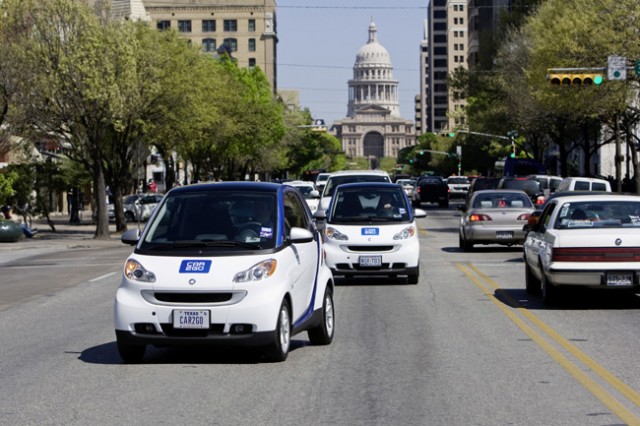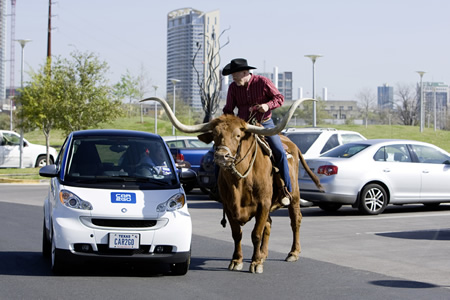Recently, I ventured down to Austin, Texas for the famed SXSW Festival, which began as an attempt to keep the state capital “weird.” In the midst of jamming out to new, up-and-coming rock bands and enjoying the many free refreshments and foods given out by various vendors during the events, I stumbled upon maybe the weirdest thing in ‘big truck’ Texas: a tiny Car2Go.

Austin’s Car2Go is an automobile ride-sharing program that prides itself on its fleet of reduced emissions, “environmentally friendly” Smart Fortwo cars. In their own words, Car2Go is “perfect for the city: it’s small, agile, and fits in every parking space,” but most importantly, it’s “fun to drive!” Plus, they are reasonably low in cost to use — to get a membership card is a one-time fee of $35, and then every minute used is 38 cents, including solid hour and day rates, dependent upon your trip. Once you are done with the car, a patron just simply drops it off in one of the city’s ever increasing service area. And don’t worry about breaking your wallet on gas prices, because gas is 100% free! As if that wasn’t enough, Car2Go actually rewards you 20 free driving minutes every time you take a few minutes out of your day to fill up the tank (as long as it’s down to a quarter tank full). Plus, public parking becomes free: Car2Go simply picks up the tab, as it contracts a deal with each participating city, allowing each vehicle of the fleet to be exempt from paying public parking meters. And for the true environmentally friendly driver, there is even an electric car option (though they are less popular due to poor charging station infrastructure within the city thus far…but they are working on changing that!).
But the most impressive part of Car2Go, as I witnessed in Austin, is that it’s actually really popular. Especially when considering the need for everything in Texas to be BIG, the tiny Car2Go has somehow overcome the Texan norm. Throughout the week, I frequently saw these little 2-seaters whip around town as I’d walk down South Congress and up the Red River District. At times, I noticed concert-goers (somewhat unsafely) cram four people in whatever space was left in the car, headed to their next venue. At other times, I’d spot a solitary band member transporting all of his bandmates’ equipment to their next gig. Car2Go looked like a sound solution to public transportation (especially in this particular city where there is no metro/subway system).

But can the Car2Go system gain the same amount of popularity here in New York City as it has in Austin? In a city with arguably the most aggressive and unique driving in the nation, it’s hard to fathom a “shoebox with wheels” keeping up with the pace of New York cab drivers, merciless truck drivers, and impatient suburban SUV owners.
Austin is well suited for this system; it is as if Car2Go is a puzzle piece that fits certain urban landscapes…and one place that fits happens to be Austin (in addition to 16 other cities worldwide that have a similar transportation environment). Unlike NYC, driving in Austin is much more relaxed: speed limits average 15mph (that is, within the confines of the city; the suburbs are a different story), drivers are seldom in a feverish rush and are more respectful of smaller, less traditional forms of transportation, as rickshaw and pedicycle services are also used quite frequently.
But even if NYC did embrace the Car2Go Fortwo: would it necessarily benefit the environment in the city? Are the Fortwos actually as green as they might appear?
Compared to a full size car or a pickup, Fortwos are marginally better in fuel economy. But if you look at the bigger picture, the answer changes completely. Because the worst effect would be this: Smart Fortwos have the tendency to convert public transit users — who typically cannot afford or wish to own a vehicle of their own — into energy-wasting shared automobile users. They even tend to draw from the population of city cyclists. So if a driver in a Car2Go was pulled from mass transit or from a bike seat, that is a major step backwards for the environment. [An alternate opinion is linked at the end of the post.]
David Owen, a writer at The New Yorker, addresses this issue in his book, Green Metropolis: Why Living Smaller, Living Closer, and Driving Less Are the Keys to Sustainability. He describes cruising the streets of New York City with a friend who had just purchased the Smart Fortwo when it was still a novelty. As bystanders admire and comment on the cute, apparently “environmentally-friendly” car throughout the day, they encounter a Brooklyn resident who becomes very intrigued by the Fortwo. After asking a few questions and hearing that the basic model costs only $12,000, the man expresses interest in buying one, since “it would enable him, finally, to stop using the subway.”
At this, Owen points out the crucial fact: “the world does not need an inexpensive car that tempts city dwellers to abandon public transit.” Owen’s point, emphasized by transportation planners everywhere (and our own interviews with Projjal Dutta of the MTA), is that public transit, subways, light rail and buses, are vastly more efficient and environmentally friendly than even mini-automobiles like the Fortwo (in fact, the Fortwo only gets a little over 30 mpg, which is unimpressive for a car of its size and engine). And the Fortwo in particular only has the capacity to transport two passengers. In New York City, the sheer density and immense public transportation demands — where the 6 line, at peak, delivers 1000 passengers every 90 seconds to midtown — means that mass transit is the only meaningful system available, and so resources are better spent improving it. (Touch screen maps, for instance?)
Bearing in mind the criticisms about applying Car2Go to NYC, it’s sadly true most American cities are closer to Austin in design; spread out, and without robust mass transit. To this conundrum, car sharing is a fascinating innovation. NPR just produced a report on the trend away from car ownership, which they reported from Seattle (where Car2Go is already a success). The take-away quote from the transportation planner on NPR: “People of my generation believed that our private automobile said a lot about who we are, that [it] defined our power and our status. The younger generations don’t seem to be buying into that anymore, and they are seeing automobiles as simply a tool.” And we’ve covered the same trend in City Atlas — exploring which is more important to young people, your car or your smartphone.
Visitors to Austin constantly see T-shirts and posters with messages about how the city’s residents do not want you to move into their ‘prized, exclusive’ city — typically pointing you to Dallas as the “better” option — perhaps New Yorkers should express our concerns about Fortwo car-sharing with a suggestion as to a better place for car sharing to take hold:
Welcome to New York.
Please don’t bring your Car2Go here.
(But we hear New Jersey is nice.)
____
An update to this post: Stephen Miller, a grad student in city planning at Pratt and reporter at Streetsblog, informs us that there is research showing car sharing can actually be beneficial overall, by reducing total car use. The researchers find, somewhat counterintuitively:
“Carsharing can substantially reduce the number of vehicles owned by member households, despite the fact that 60 percent of all households joining carsharing are carless.”
It’s impossible not to note that the research is endowed by Honda. But it is possible that this hasn’t affected the accuracy of the research.